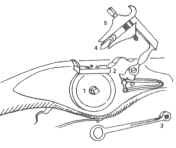
Firearms
Following the advent of gunpowder in the 15th century, it was soon discovered that if the powder was contained in a tube, it could project a missile in any desired direction when the powder was ignited. Many experiments were carried out to find how much powder was needed, how much metal to use and to what size.
As a result, many types of gun were invented to harness this power. Originally these were various types of cannon but the weight of guns was a problem for any army on the move. Thought was given to this problem and by the 17th century, the 'Matchlock-musket' had been developed and was the most portable firearm for a soldier. The cannon had been around much longer but now he could put one to his shoulder!
Things continues to move on and gradually other weapons were introduced including fire-lock muskets and the pistols, which could be used single-handed - useful if you were riding a horse at the time!

The Match-lock Musket was the favoured soldier's weapon of the time. This was a fairly heavy firearm to carry and to use. At the beginning of the English Civil War, many soldiers carried a rest, a wooden pole to support the muzzle before 'giving fire'.
As the name implies, a slow-match, or burning match-cord was used to ignite the black-powder in the flash-pan. The musketeer often needed to blow the cord to keep it smouldering.
The simple trigger mechanism was made by the lock-smith. Hence the name 'match-lock, flint-lock' etc.
The Fire-lock Musket and Dog-lock musket were types of flint-lock musket that appeared later in the English Civil War. The mechanism was a little more complicated, but had the advantage of being safer. There was no smouldering match-cord to ignite supplies of black-powder or give away a musketeers position at night.
The Carbine was a shorter version of the unwieldy musket, developed to be used by cavalry. They later favoured a pair of wheel-lock pistols carried in holsters on the saddle.
The Wheel-lock Pistol this was a heavy pistol with a crude clockwork mechanism that had to be wound-up with a 'spanner' - this is thought to be the first use of the name for this tool. A flint fired the powder in the same way as the musket but it took longer to prepare for use and soon went out of favour.
 Here
is a diagram of the wheel-lock mechanism. The wheel (1) protrudes
into the priming pan (2) The clockwork spring mechanism behind the
wheel is wound-up with the 'spanner (3) until it locks. When
the trigger is pressed, the flint or iron pirates (4) held in the dog-lock
(5) is brought into contact with the revolving wheel. The sparks
created ignited the powder in the pan to fire the charge. There
were some muskets as well as pistols with this mechanism, used by officers
and mounted soldiers.
Here
is a diagram of the wheel-lock mechanism. The wheel (1) protrudes
into the priming pan (2) The clockwork spring mechanism behind the
wheel is wound-up with the 'spanner (3) until it locks. When
the trigger is pressed, the flint or iron pirates (4) held in the dog-lock
(5) is brought into contact with the revolving wheel. The sparks
created ignited the powder in the pan to fire the charge. There
were some muskets as well as pistols with this mechanism, used by officers
and mounted soldiers.

Flint-lock Pistol many patterns of flintlock pistol appeared in the seventeenth century with wooden stocks and elaborate metal fittings.
The mechanism was almost identical to that of the musket though this shorter weapon would have been less accurate.